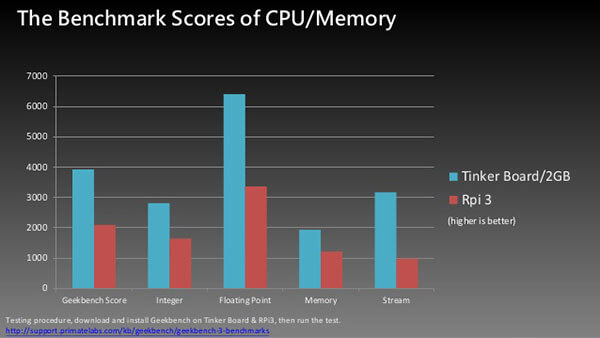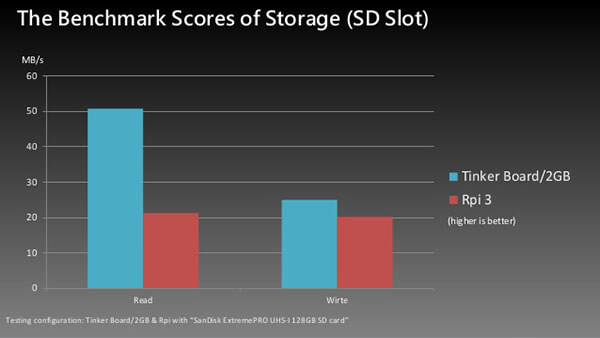To satisfy our voracious appetite for economical, easily-programmable, and open source hardware to bring our imagination to life, technology giants such as Broadcom, Intel, Texas Instruments, Samsung, and Qualcomm have come up with their own single- board computers. But none of them were successful in replacing Raspberry Pi.
Recently, Asus, the Taiwanese chip major, recently launched its own single-board computer “Tinker Board.”

Raspberry Pi vs. Tinker Board - A battle of super boards
Raspberry Pi 3 comes with 64-bit ARM Cortex-A57 based Broadcom BCM2837 quad-core processor at 1.2GHz, whereas Tinker Board comes with a slightly powerful processor, a 32-bit ARM Cortex-A17 based Rockchip RK3288 quad-core at 1.8GHz.
The GPU of Tinker Board is more powerful than Broadcom VideoCore IV GPU used in Raspberry Pi 3. The Tinker Board comes with Rockchip RK3288's ARM Mali-T764 graphics core with full H.264 4K video decode capability, whereas Raspberry Pi 3 has a standard HD output.
The Asus Tinker Board supports 192K/24-bit audio sample rates, whereas the Raspberry Pi 3 is just able to handle 48K/16-bit.
The Tinker Board has 2 GB LPDDR3 RAM which is twice that of Raspberry Pi 3. The board from Asus comes with an integrated full-speed Gigabit Ethernet port, which is a significant boost over the Raspberry Pi's 100Mb LAN. Similar to Raspberry Pi 3 Model B, integrated connectivity options such as 802.11b/g/n WiFi and Bluetooth 4 are available on Tinker Board.
Like you see in Raspberry Pi 3, Tinker Board also has the following features:
Undoubtedly Asus Tinker Board has better specs than Raspberry Pi 3. But Tinker Board loses when it comes to pricing. Raspberry Pi 3 is priced at $35, whereas Tinker Board is priced at $68.
But how do the benchmark metrics look?


Undoubtedly, the Asus Tinker Board wins in specs and performance metrics, but does that mean Raspberry Pi 3 is going lose ground to Tinker Board? I don’t think so because it's not just specs that made Raspberry Pi a revolutionary product, but it is more than that:
Support by the Raspberry Pi team: Active support by the Raspberry Pi foundation has created a sufficient knowledge base which builds enough trust among the developers to consider it for their DIY projects.
Vast user base: Raspberry Pi has a very engaged and innovative user base of makers or DIY enthusiasts because of which there is always a new project / hack every day.
Availability: Raspberry Pi has widespread and continued availability of supporting hardware.
In the early days of Raspberry Pi, the creators thought that they would be able to sell 10,000 units in its lifetime. But the Raspberry Pi foundation has sold more than a million units.
I don't see the adoption of Raspberry Pi dipping any time soon, do you?
Recently, Asus, the Taiwanese chip major, recently launched its own single-board computer “Tinker Board.”

Raspberry Pi vs. Tinker Board - A battle of super boards
Raspberry Pi 3 comes with 64-bit ARM Cortex-A57 based Broadcom BCM2837 quad-core processor at 1.2GHz, whereas Tinker Board comes with a slightly powerful processor, a 32-bit ARM Cortex-A17 based Rockchip RK3288 quad-core at 1.8GHz.
The GPU of Tinker Board is more powerful than Broadcom VideoCore IV GPU used in Raspberry Pi 3. The Tinker Board comes with Rockchip RK3288's ARM Mali-T764 graphics core with full H.264 4K video decode capability, whereas Raspberry Pi 3 has a standard HD output.
The Asus Tinker Board supports 192K/24-bit audio sample rates, whereas the Raspberry Pi 3 is just able to handle 48K/16-bit.
The Tinker Board has 2 GB LPDDR3 RAM which is twice that of Raspberry Pi 3. The board from Asus comes with an integrated full-speed Gigabit Ethernet port, which is a significant boost over the Raspberry Pi's 100Mb LAN. Similar to Raspberry Pi 3 Model B, integrated connectivity options such as 802.11b/g/n WiFi and Bluetooth 4 are available on Tinker Board.
Like you see in Raspberry Pi 3, Tinker Board also has the following features:
- Built-in WiFi
- 4 USB ports
- 1 HDMI 2.0
- 1 MicroSD card slot
- 40 GPIO pins
- A 3.5mm audio jack
- 1 Micro USB for power
Undoubtedly Asus Tinker Board has better specs than Raspberry Pi 3. But Tinker Board loses when it comes to pricing. Raspberry Pi 3 is priced at $35, whereas Tinker Board is priced at $68.
But how do the benchmark metrics look?


Undoubtedly, the Asus Tinker Board wins in specs and performance metrics, but does that mean Raspberry Pi 3 is going lose ground to Tinker Board? I don’t think so because it's not just specs that made Raspberry Pi a revolutionary product, but it is more than that:
Support by the Raspberry Pi team: Active support by the Raspberry Pi foundation has created a sufficient knowledge base which builds enough trust among the developers to consider it for their DIY projects.
Vast user base: Raspberry Pi has a very engaged and innovative user base of makers or DIY enthusiasts because of which there is always a new project / hack every day.
Availability: Raspberry Pi has widespread and continued availability of supporting hardware.
In the early days of Raspberry Pi, the creators thought that they would be able to sell 10,000 units in its lifetime. But the Raspberry Pi foundation has sold more than a million units.
I don't see the adoption of Raspberry Pi dipping any time soon, do you?

































